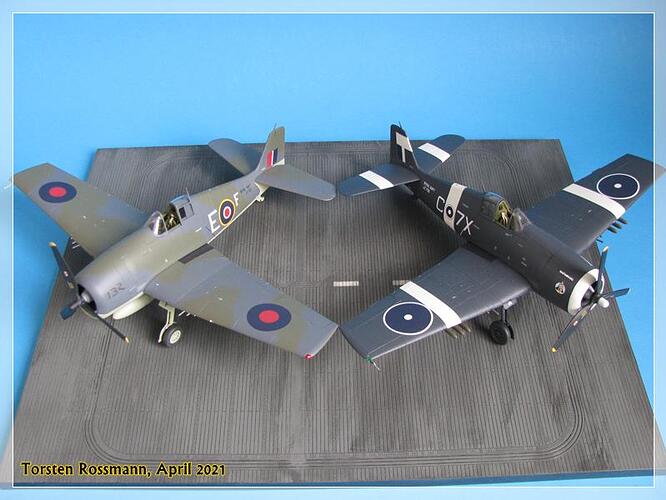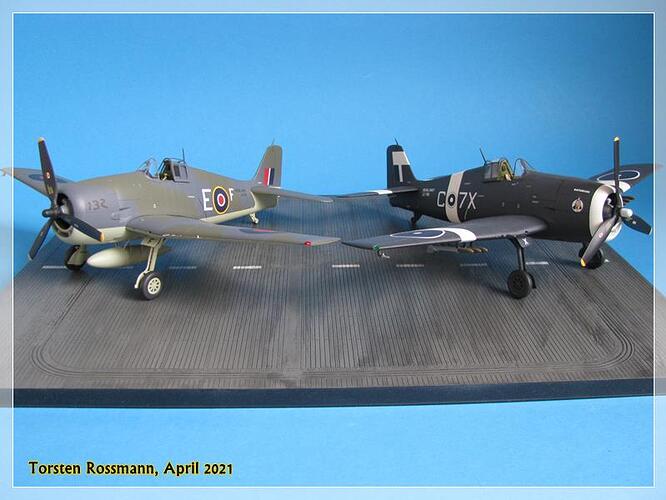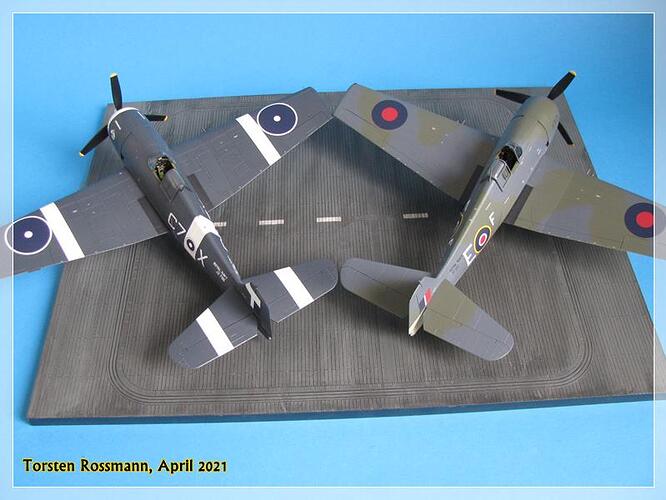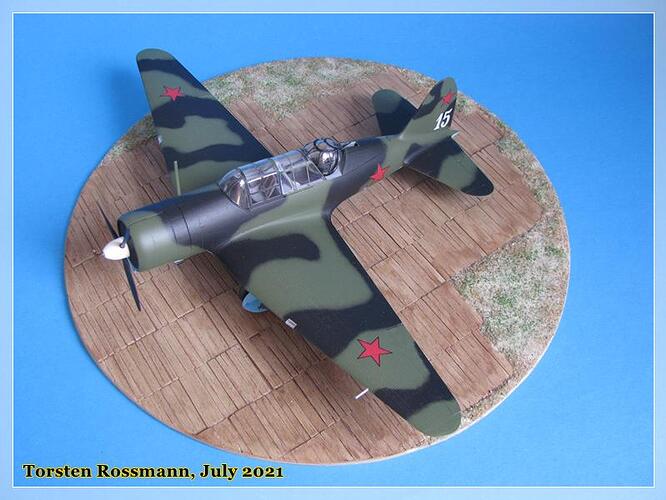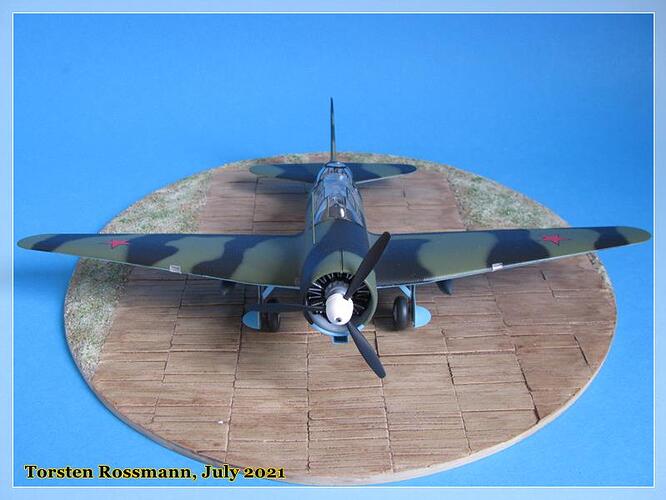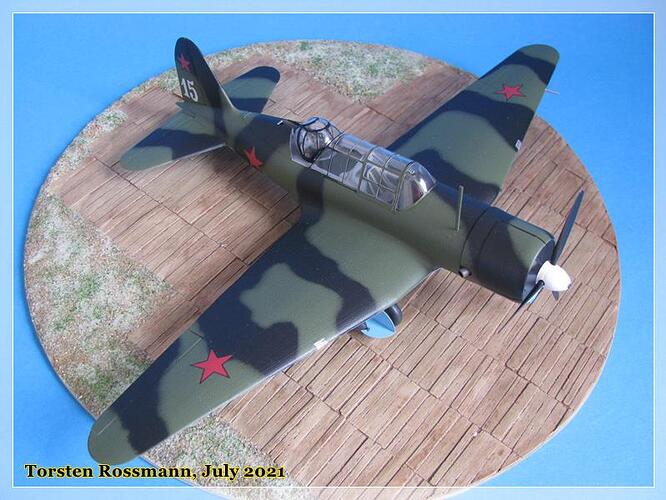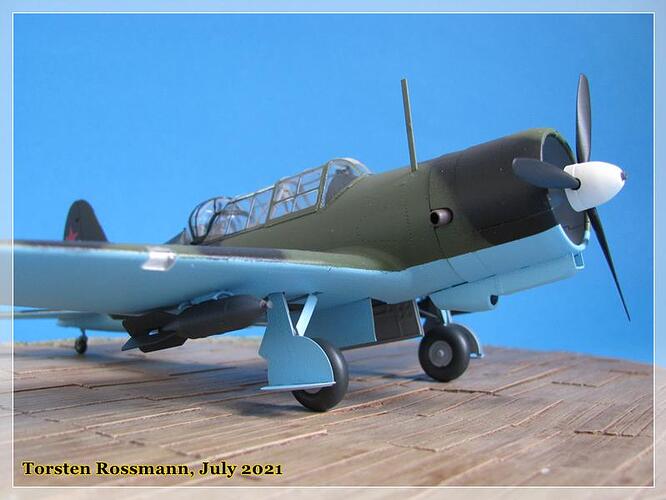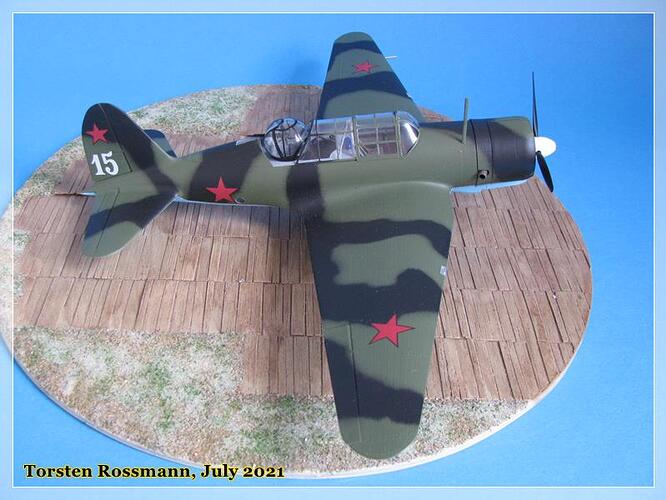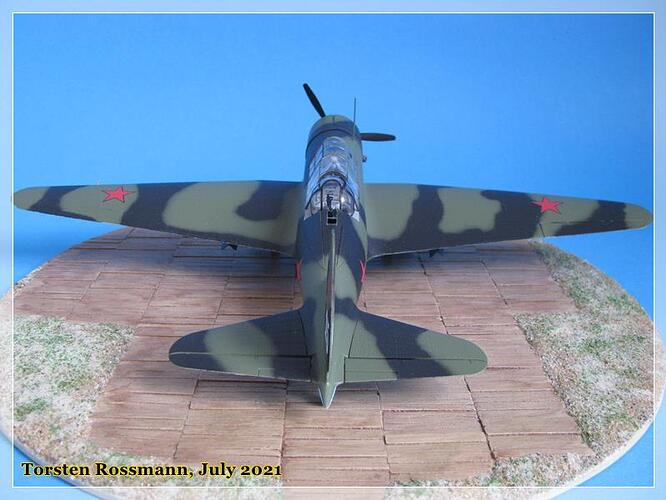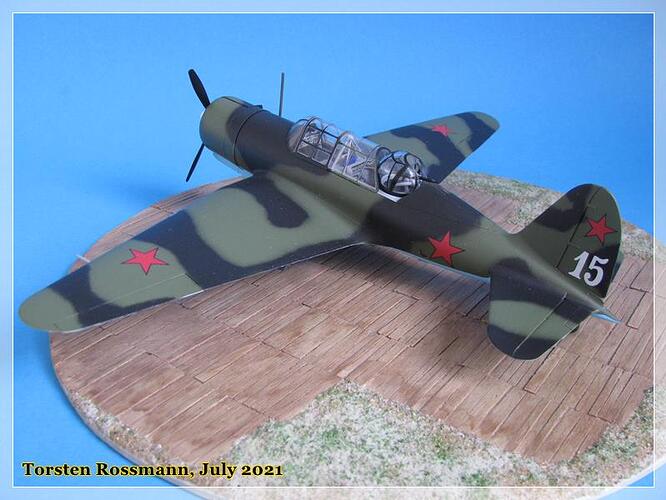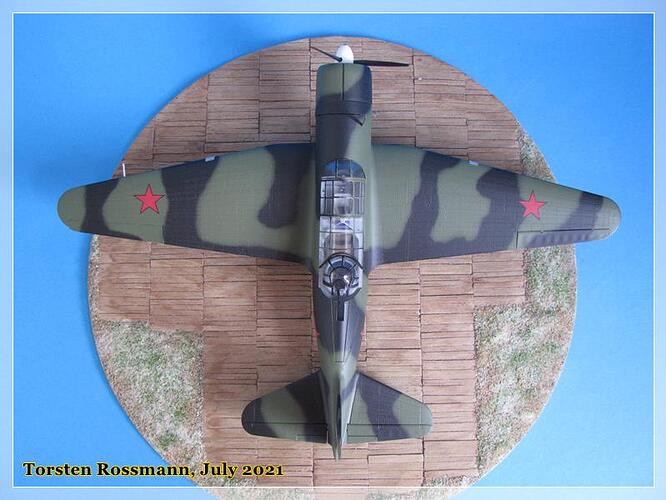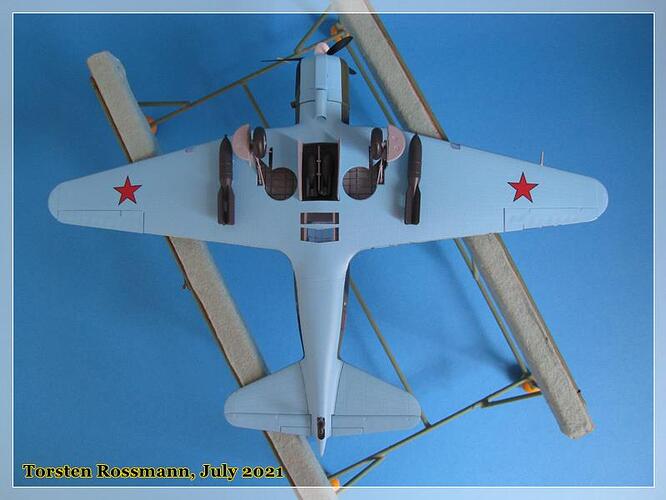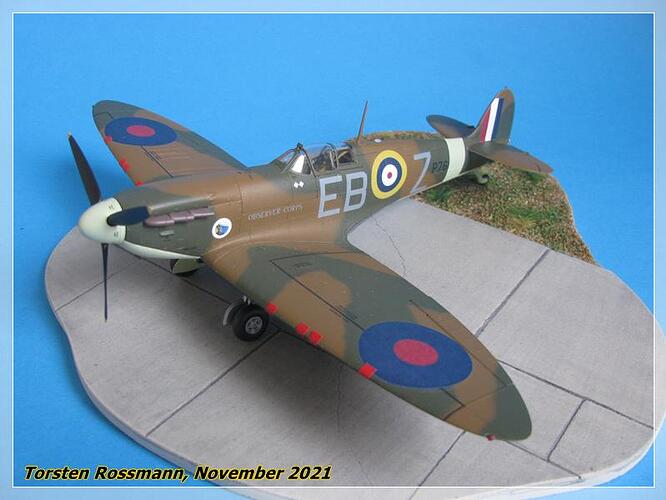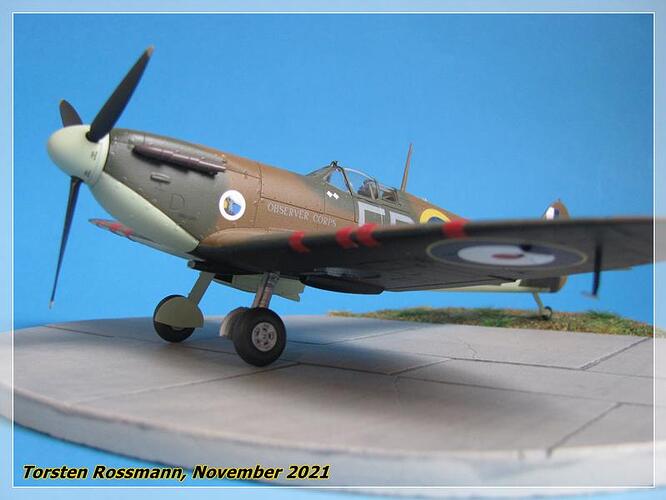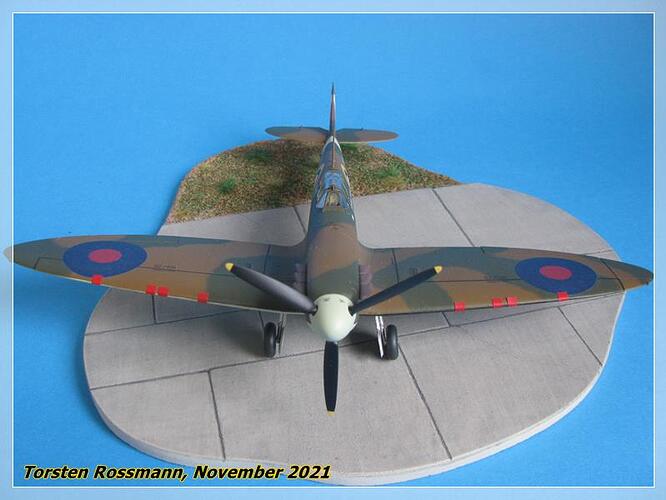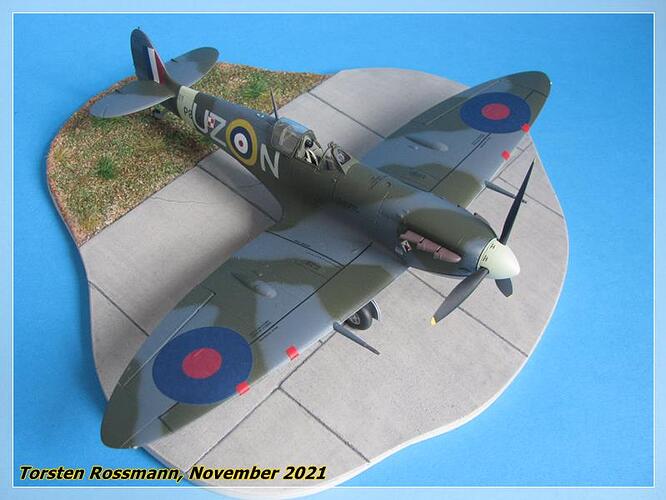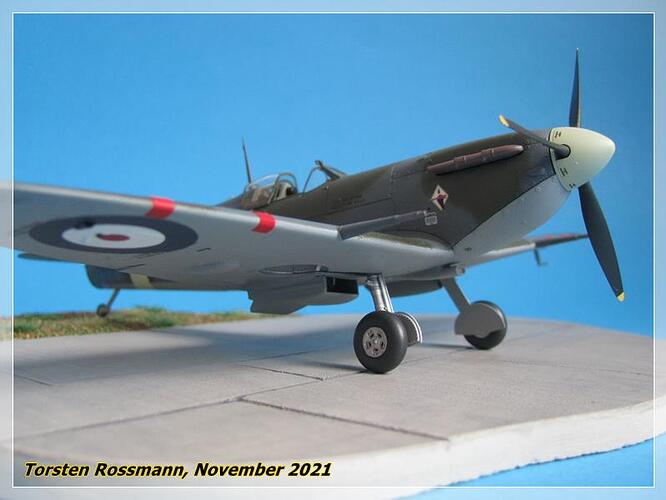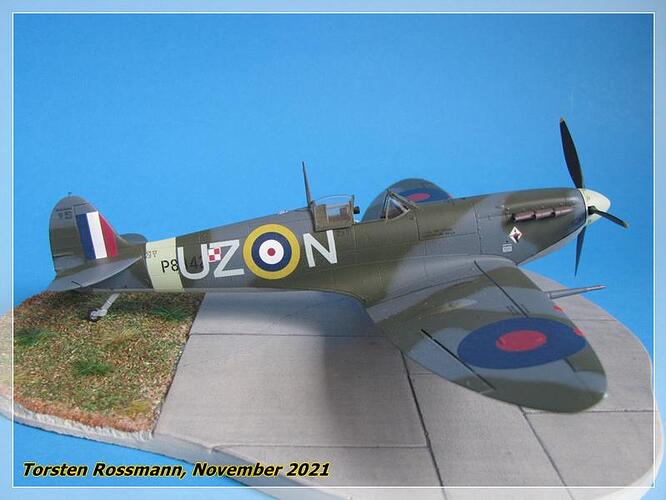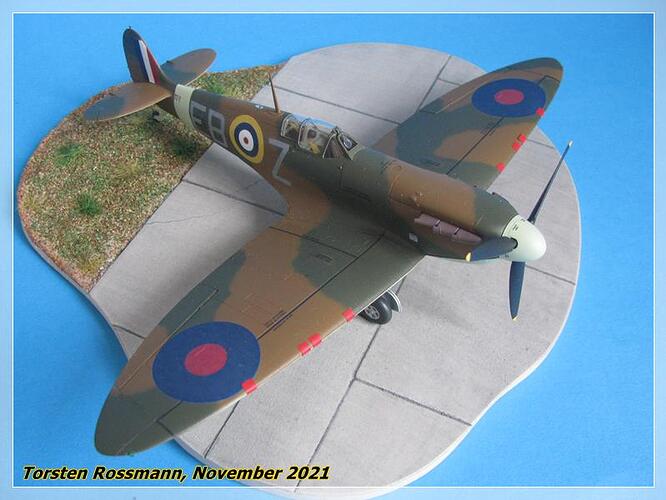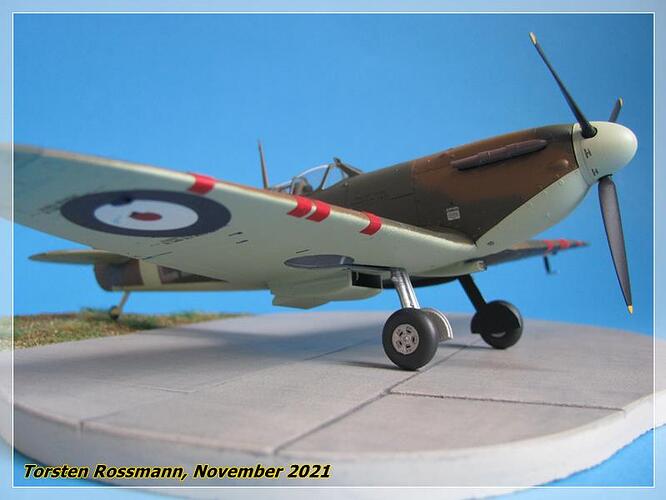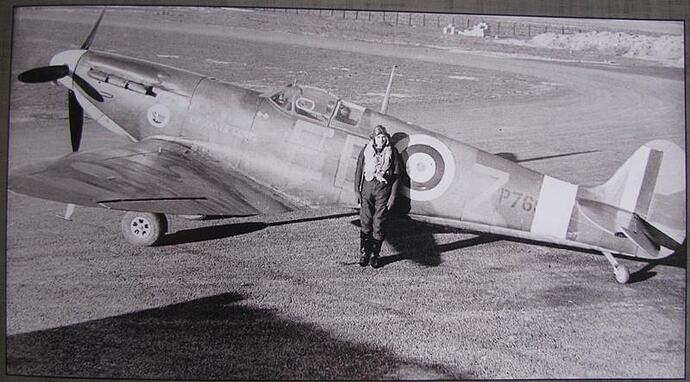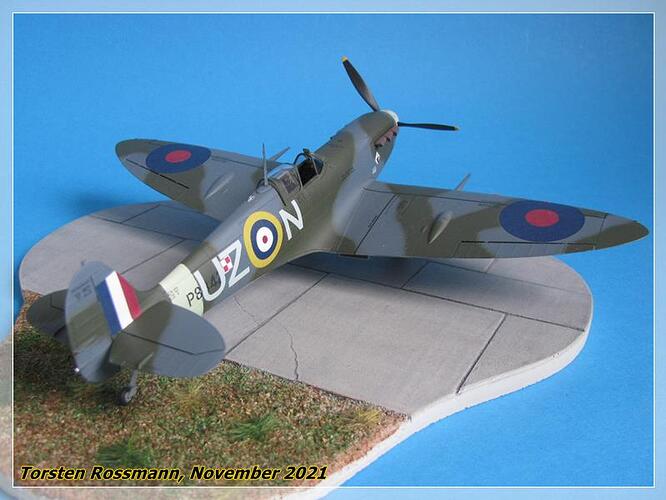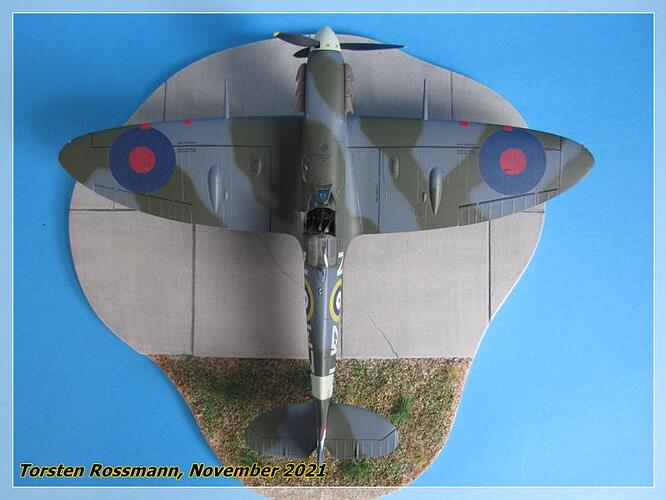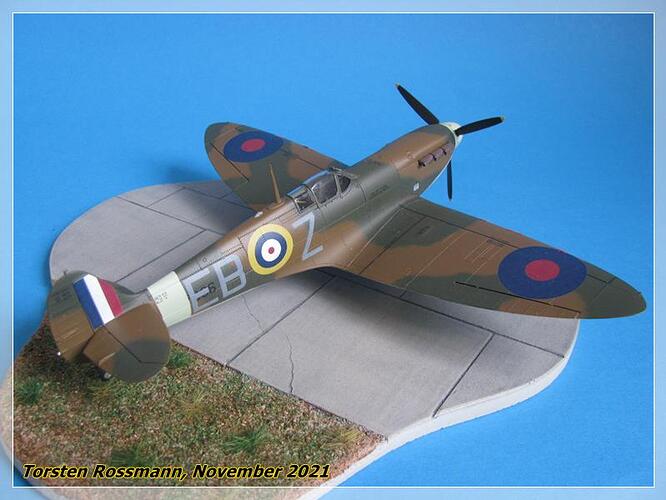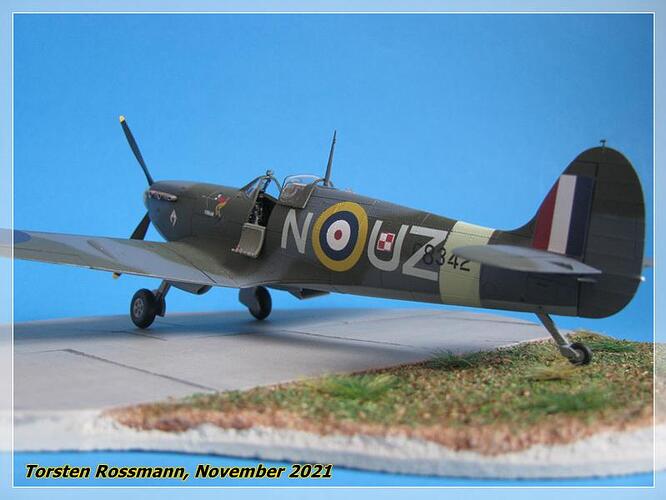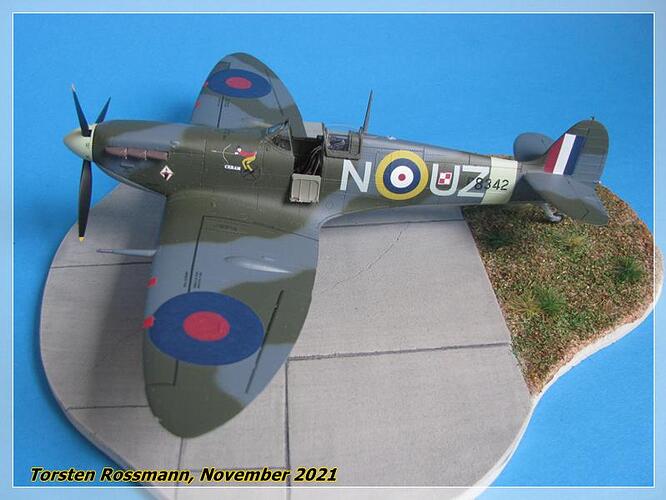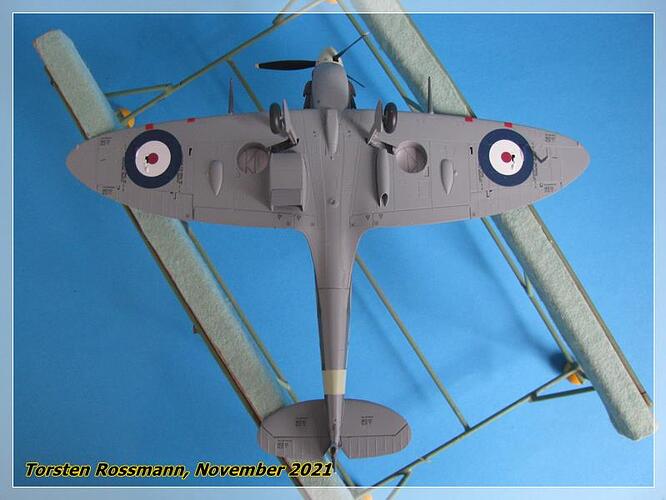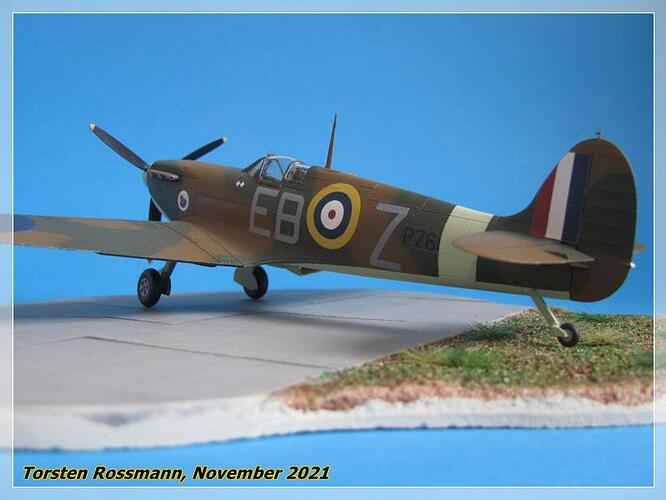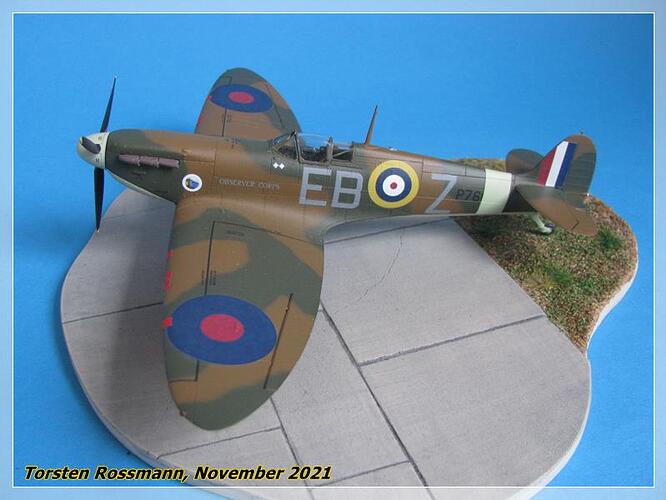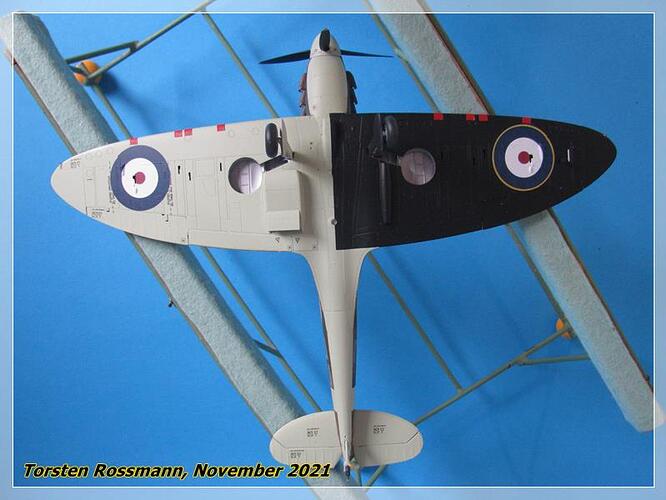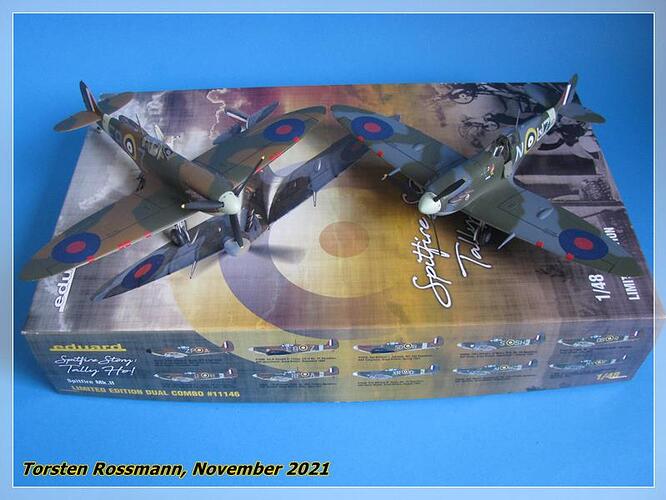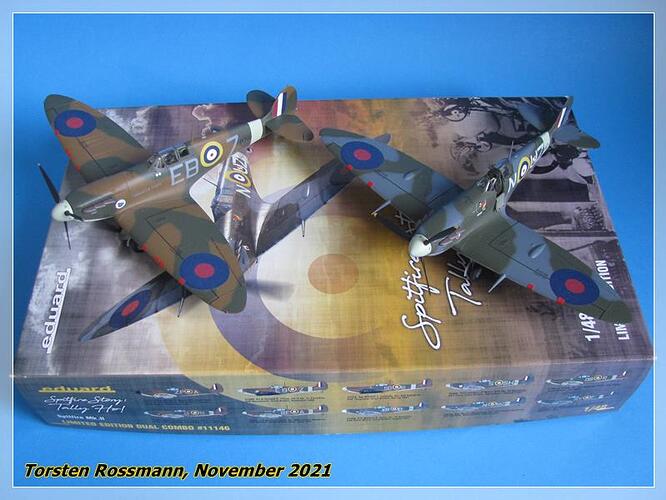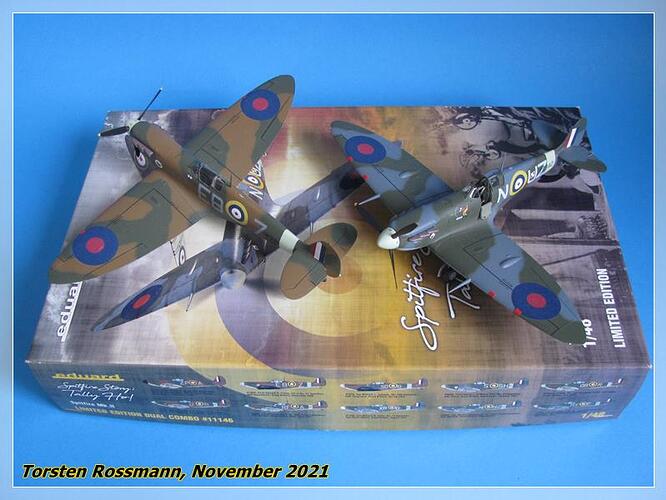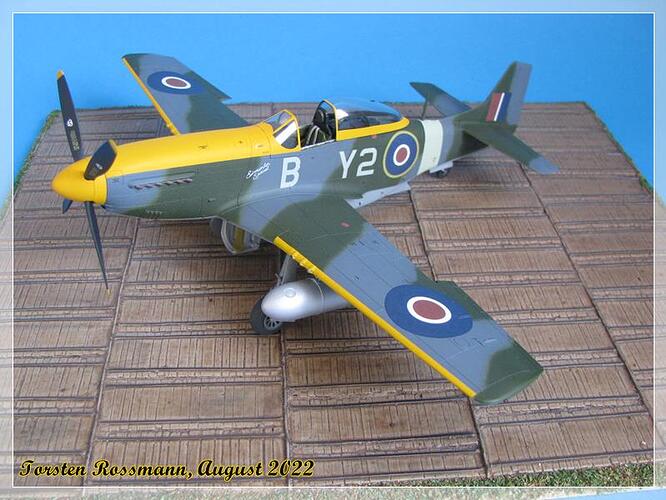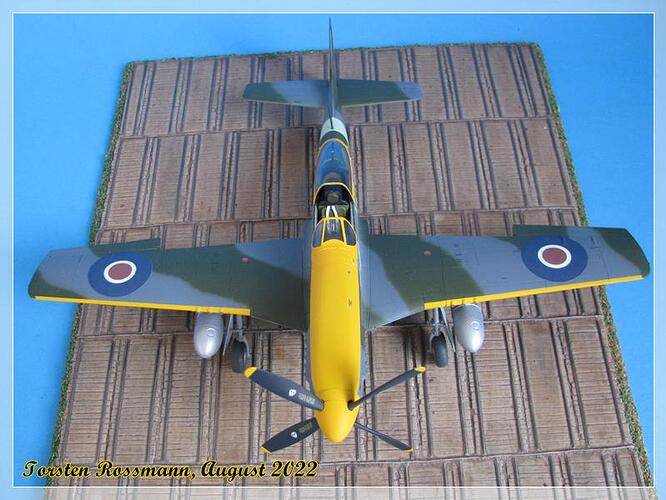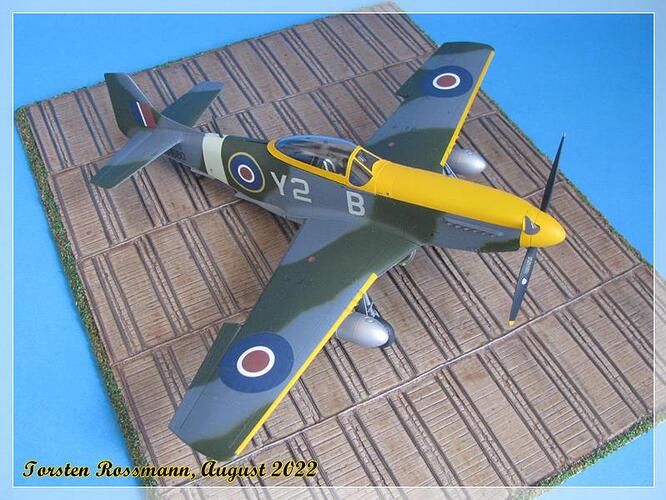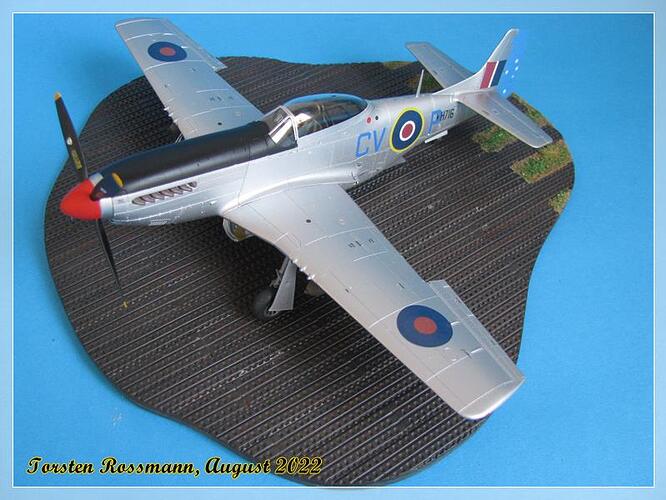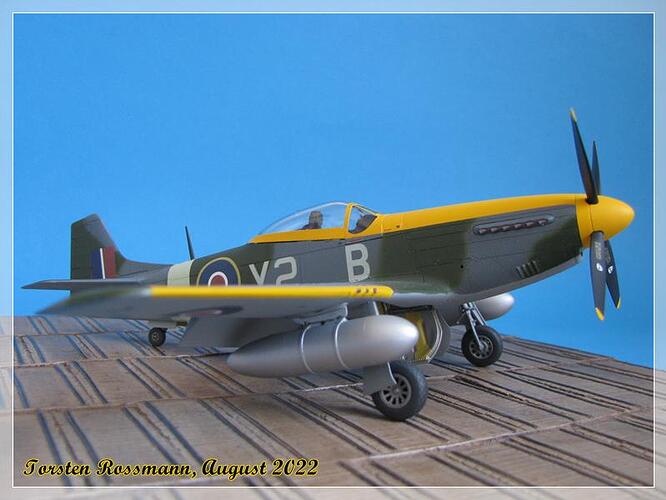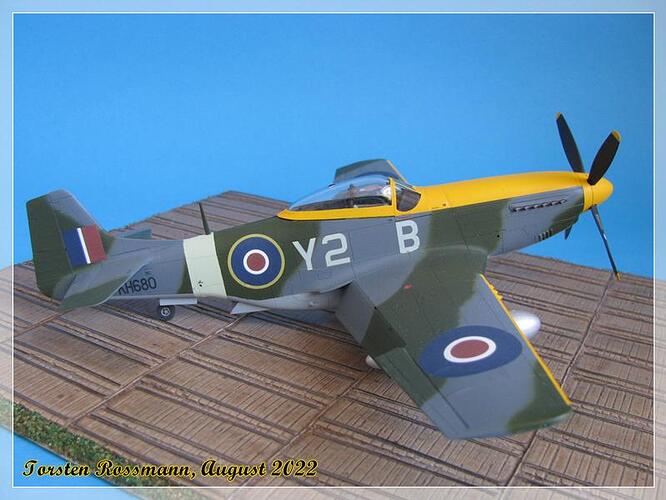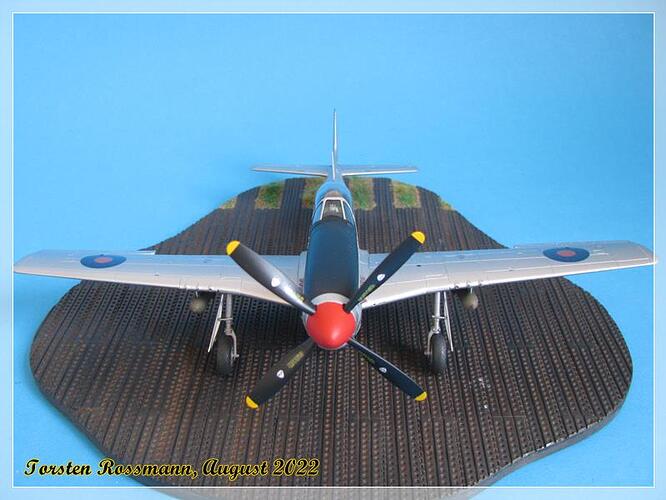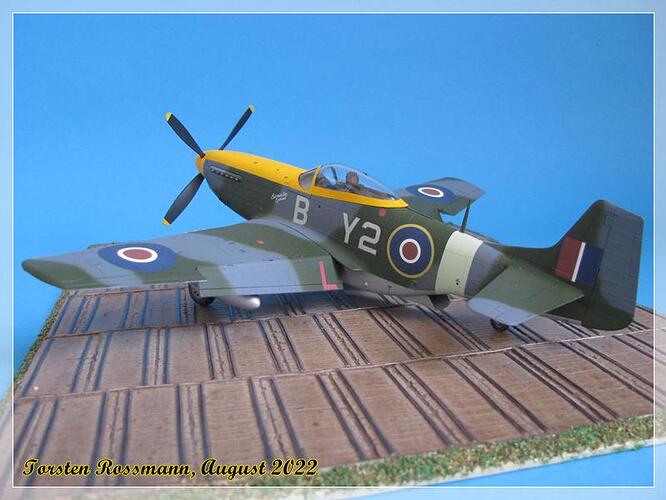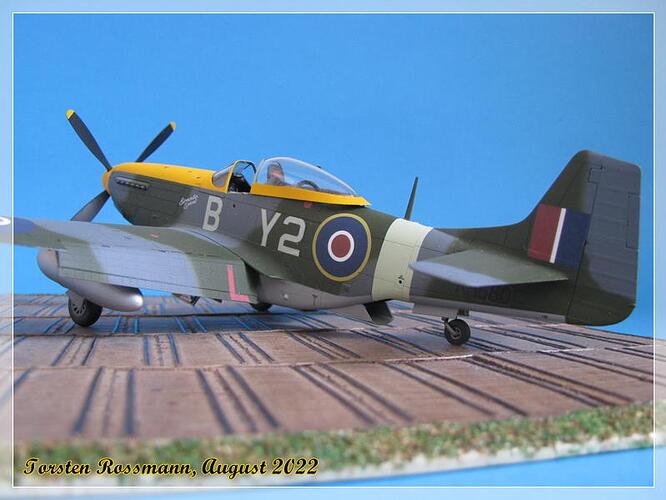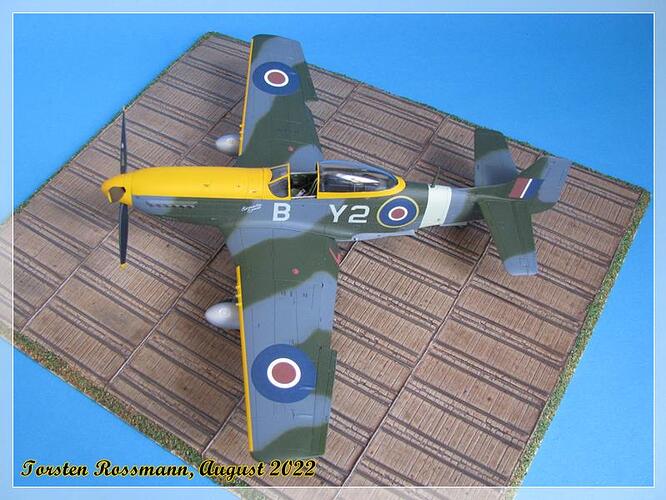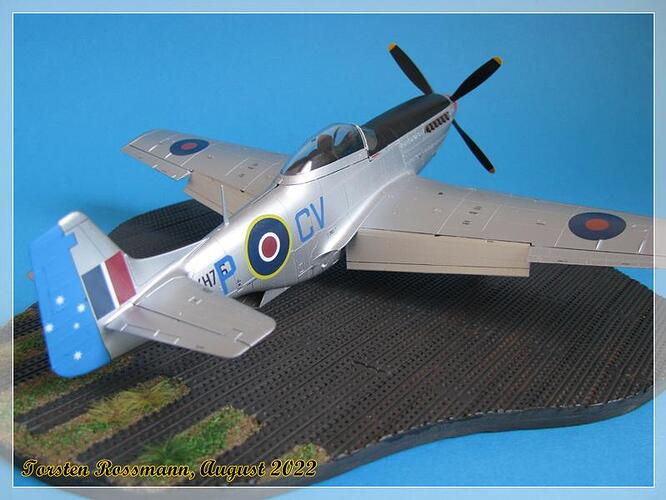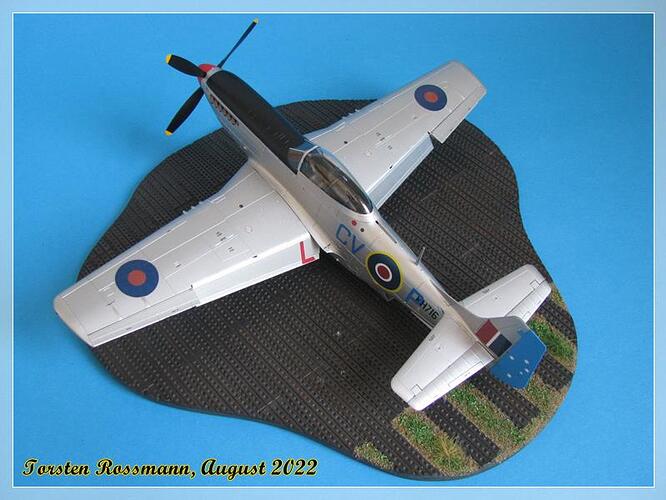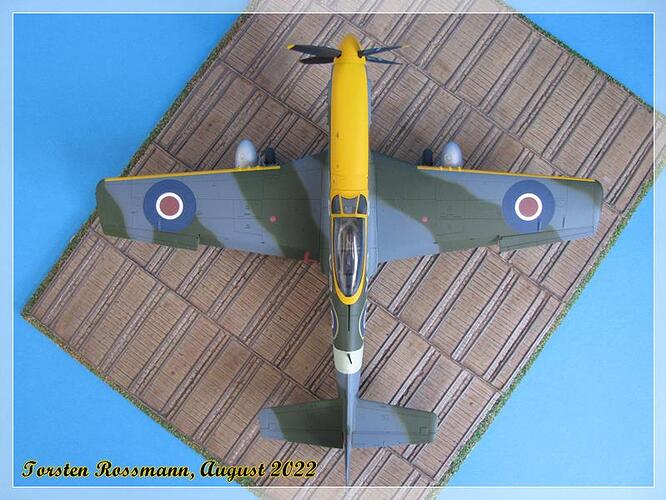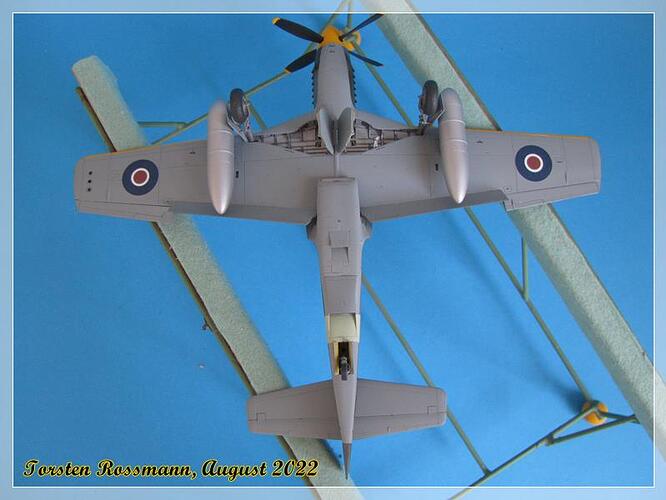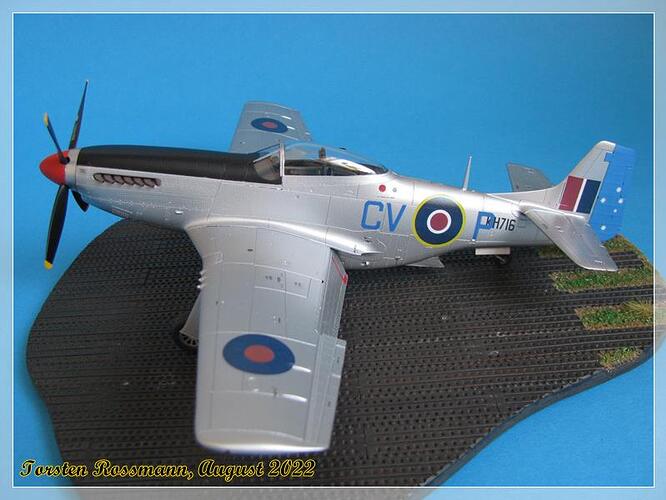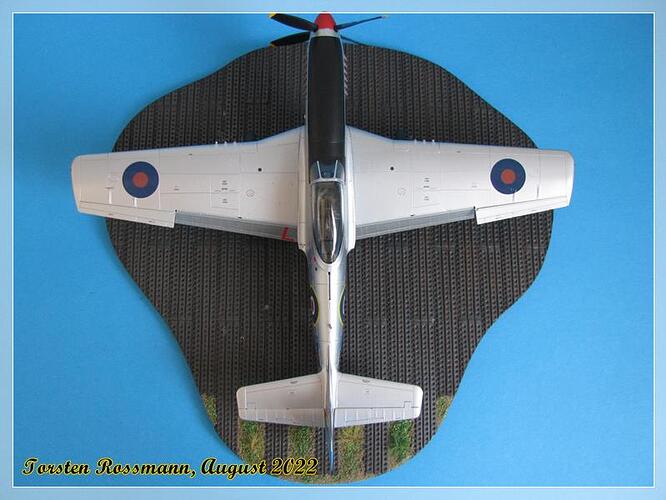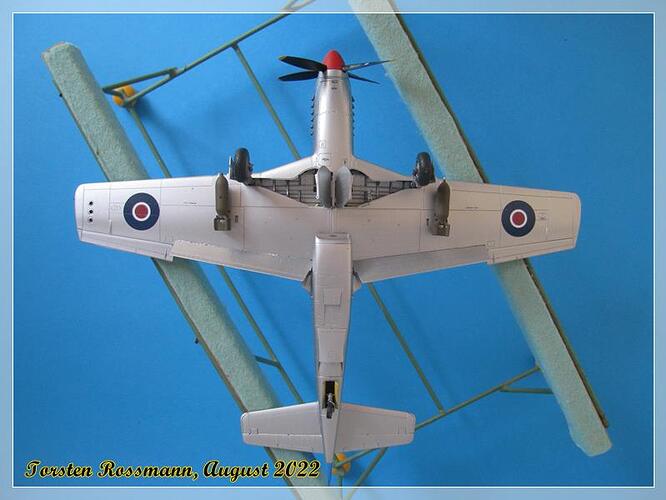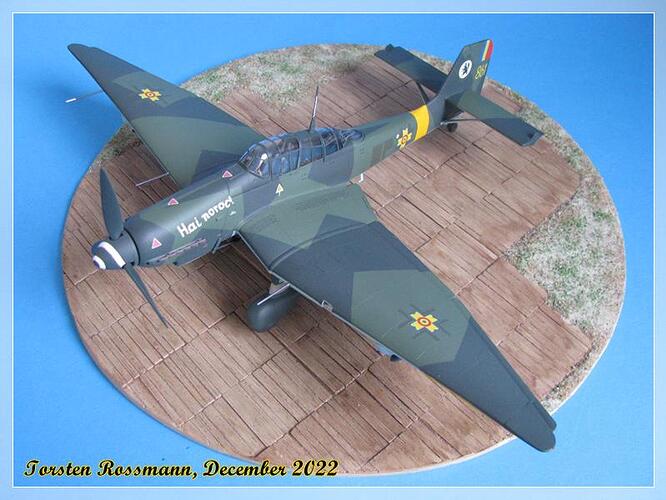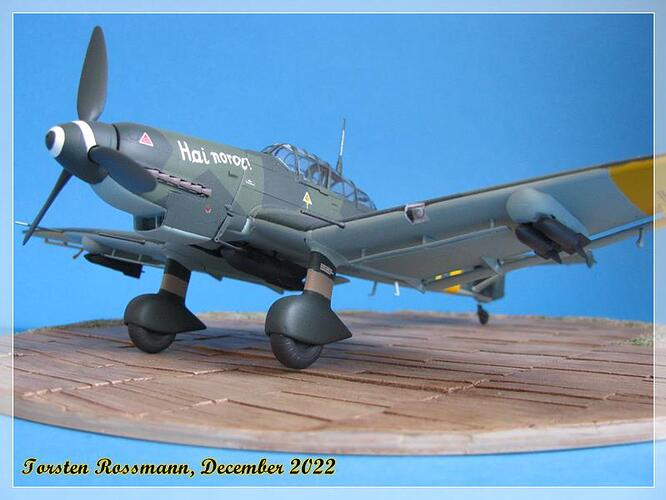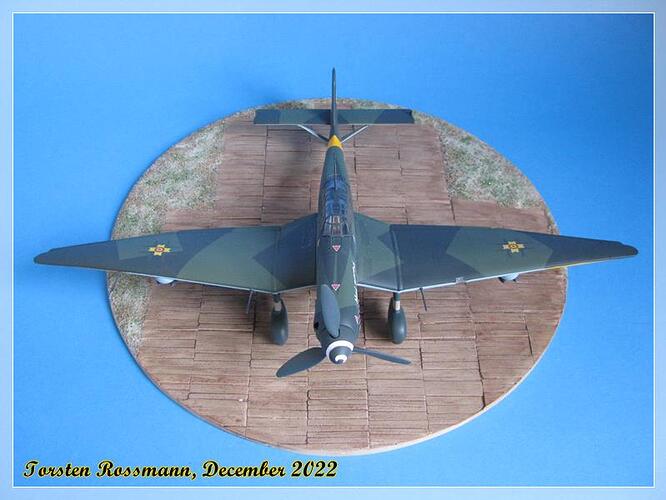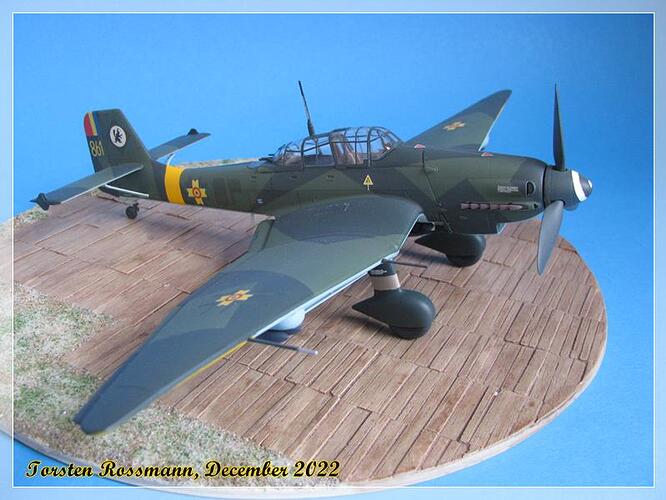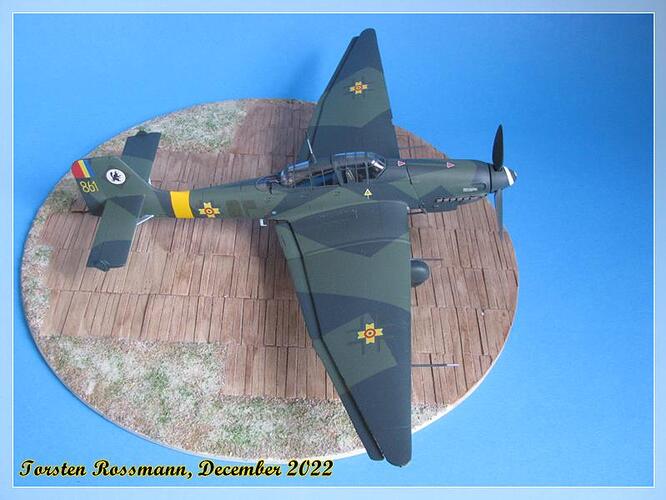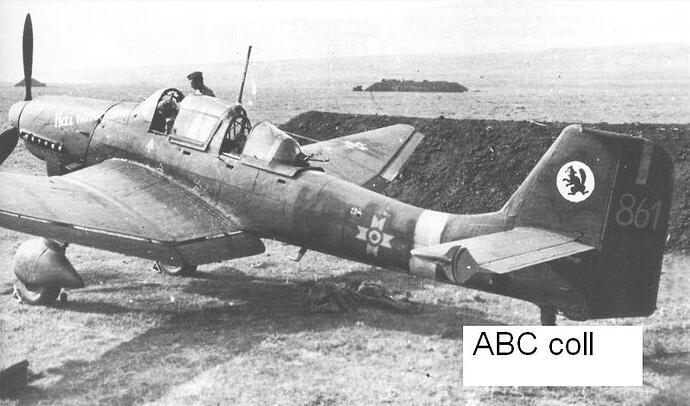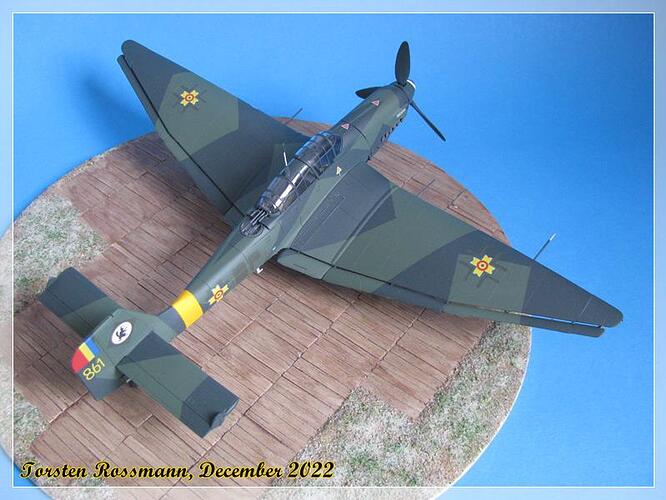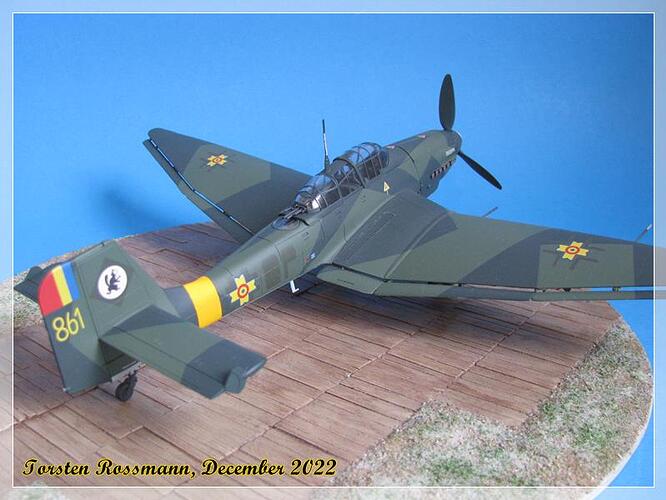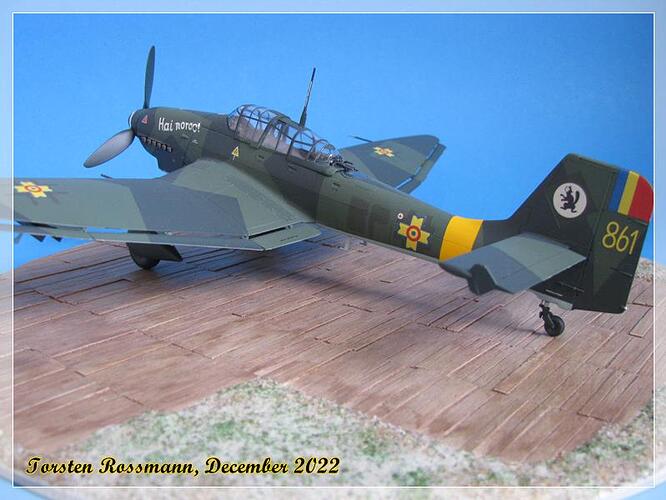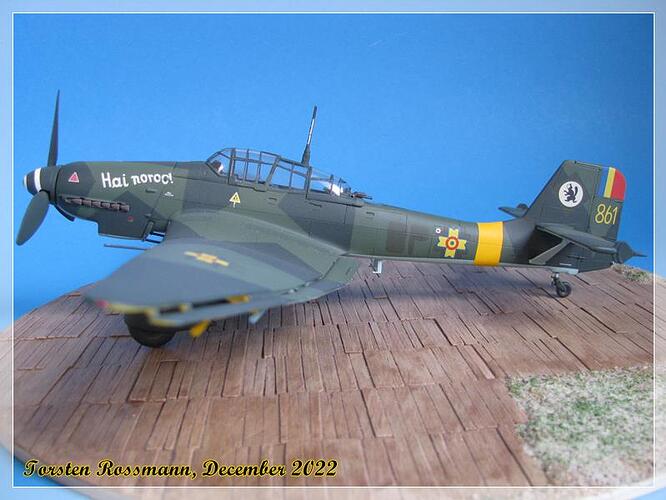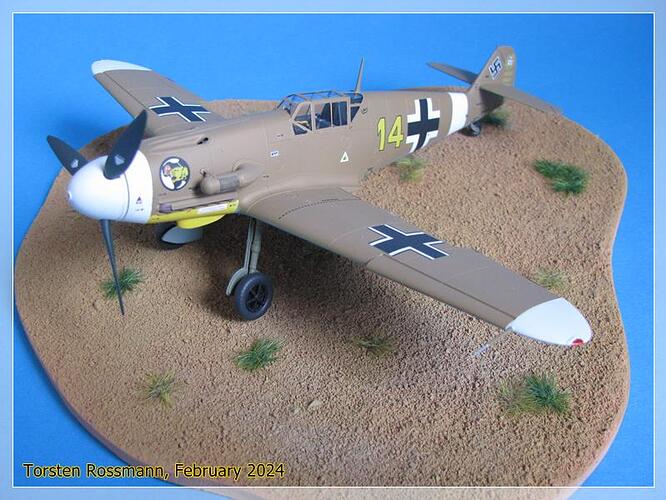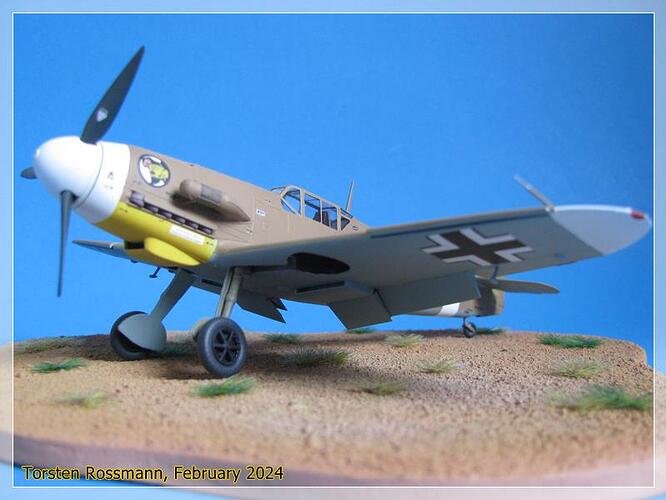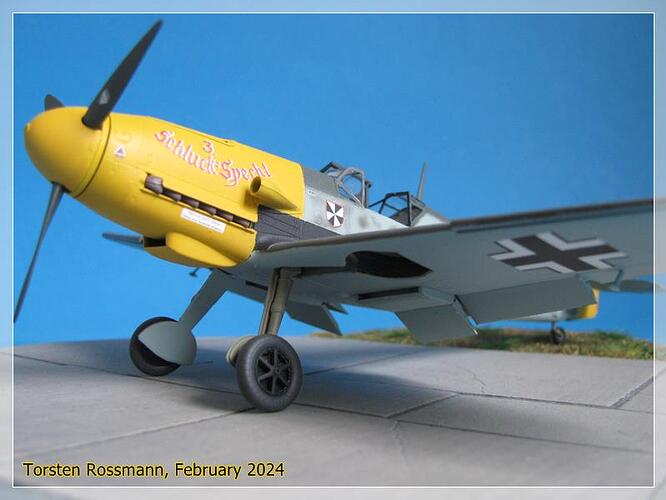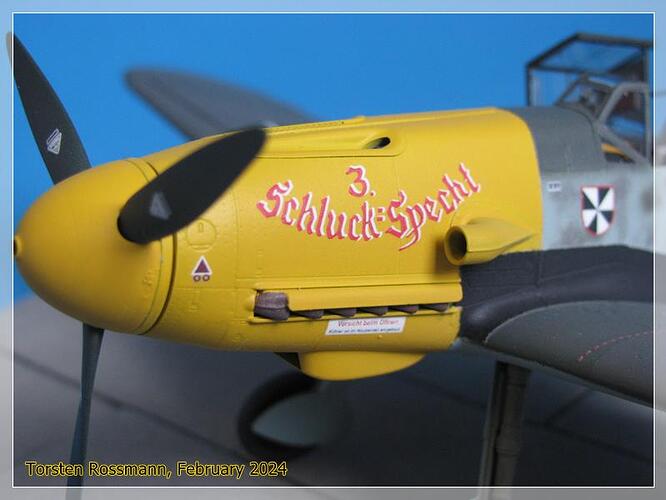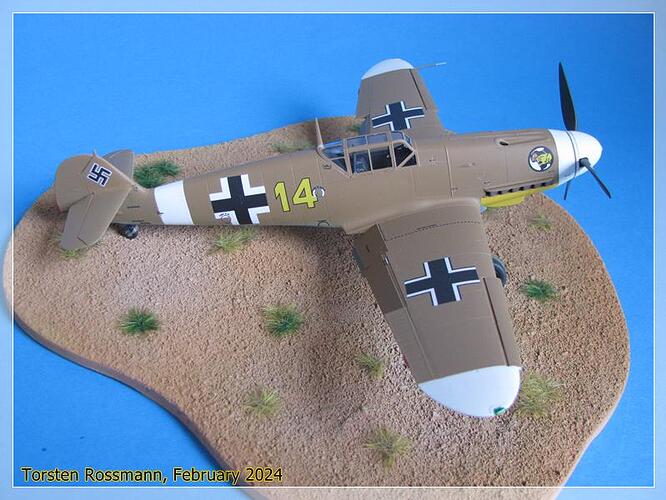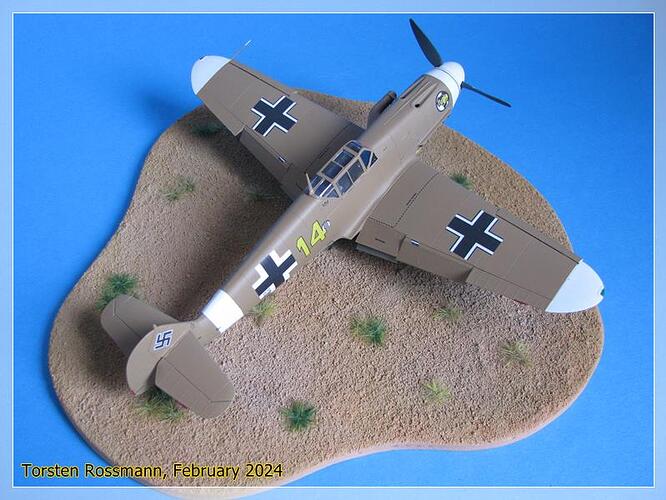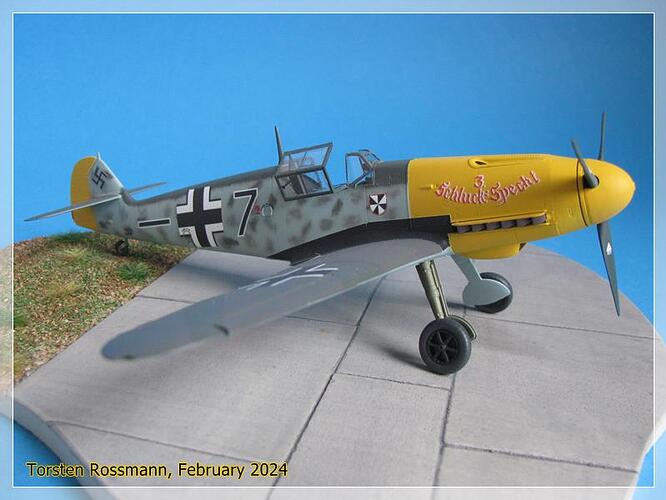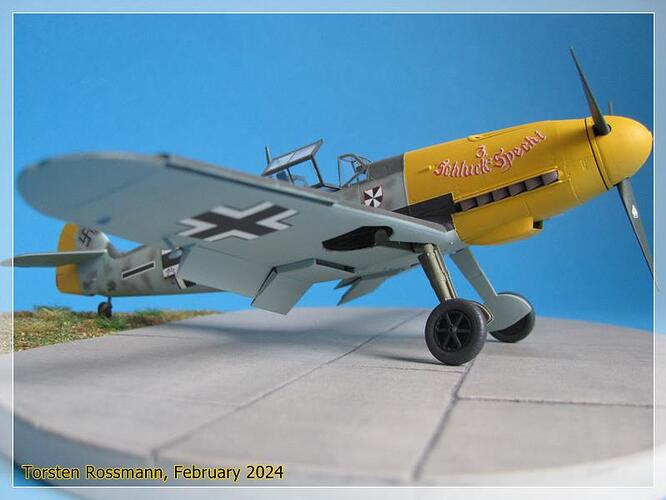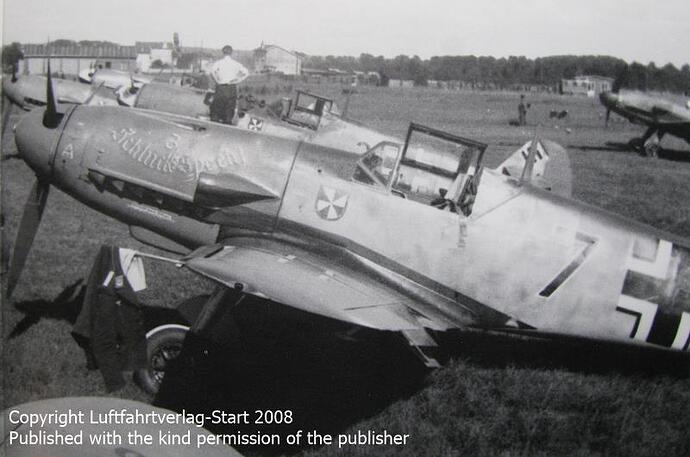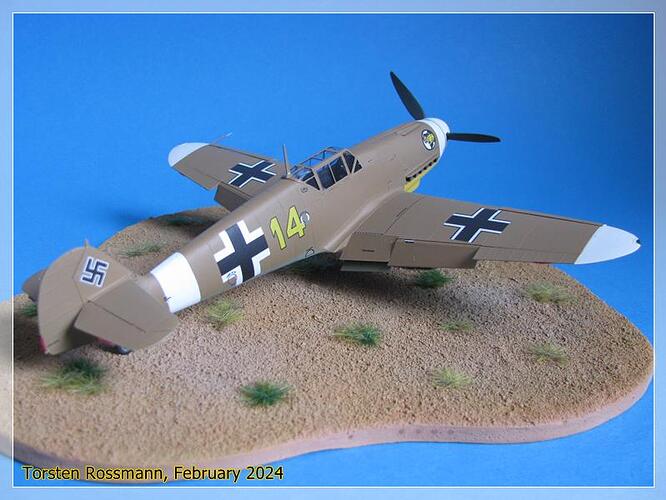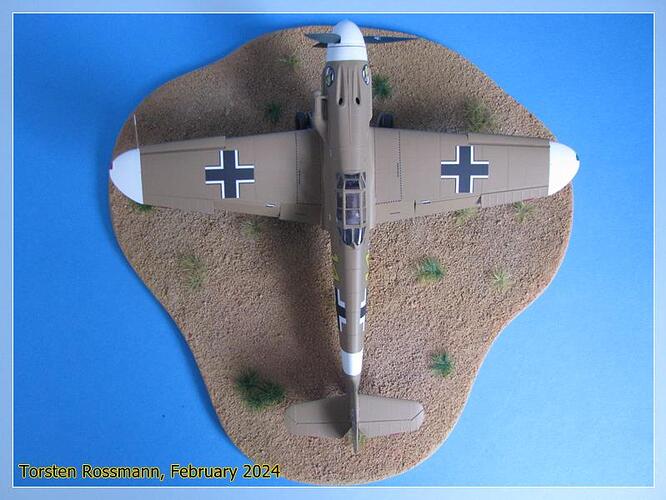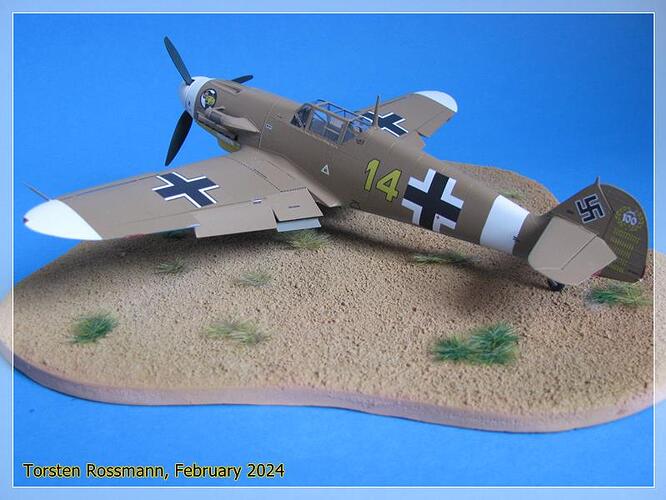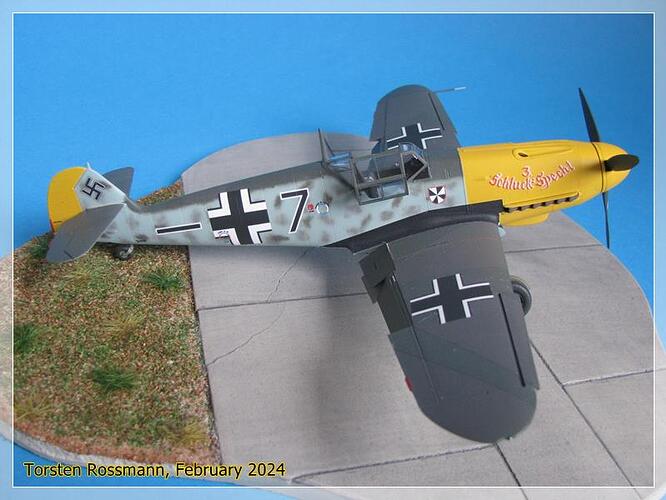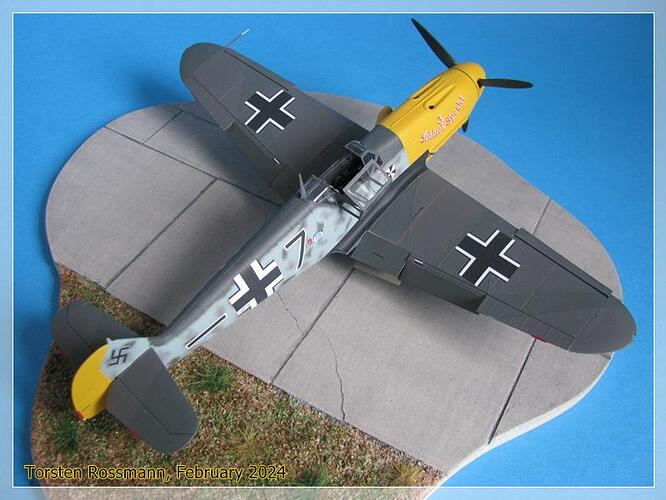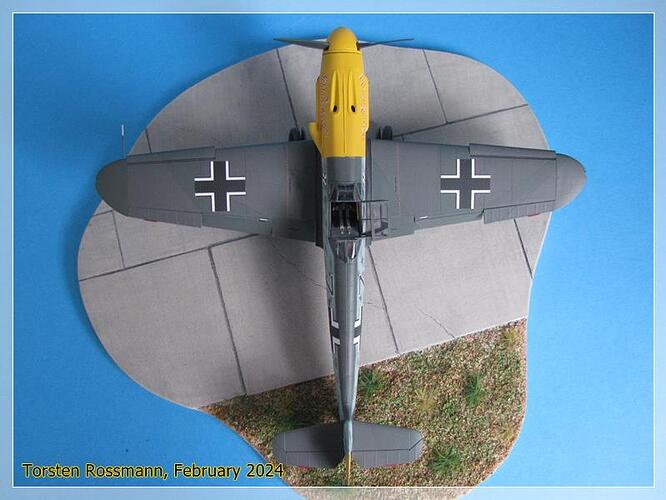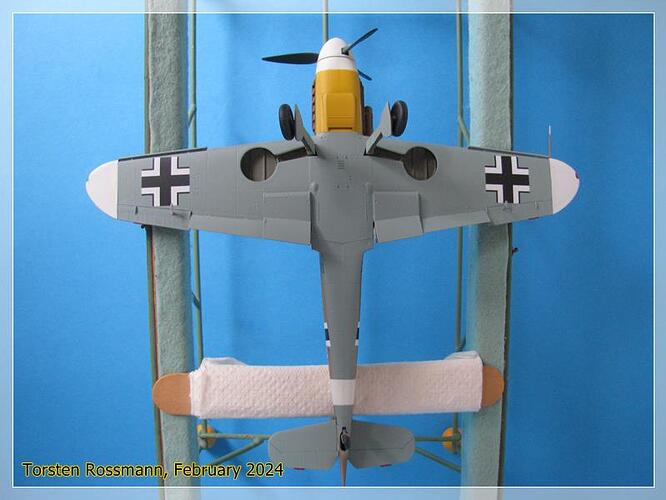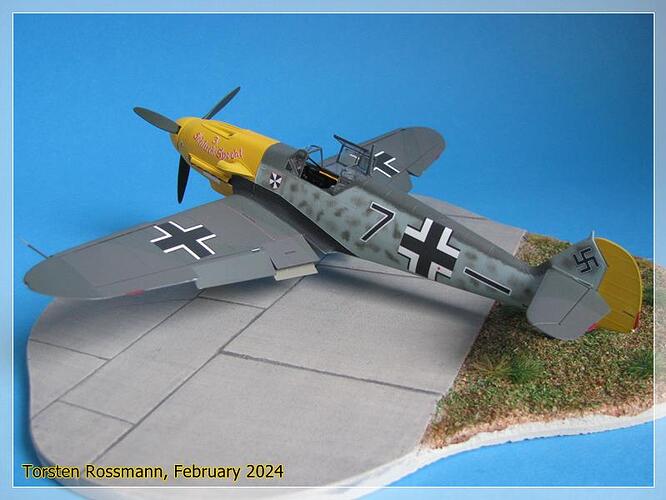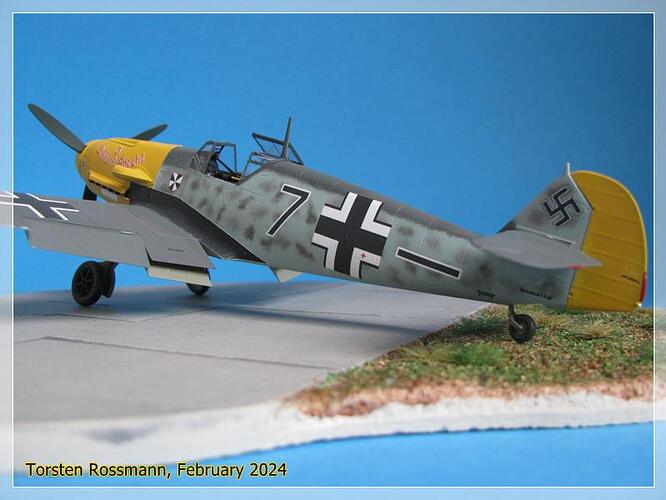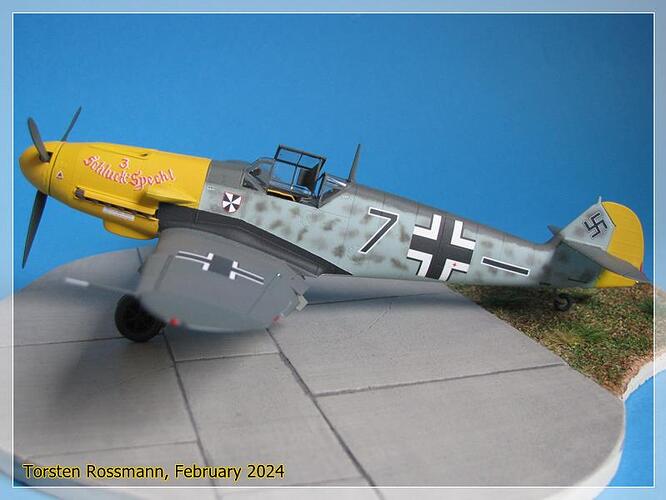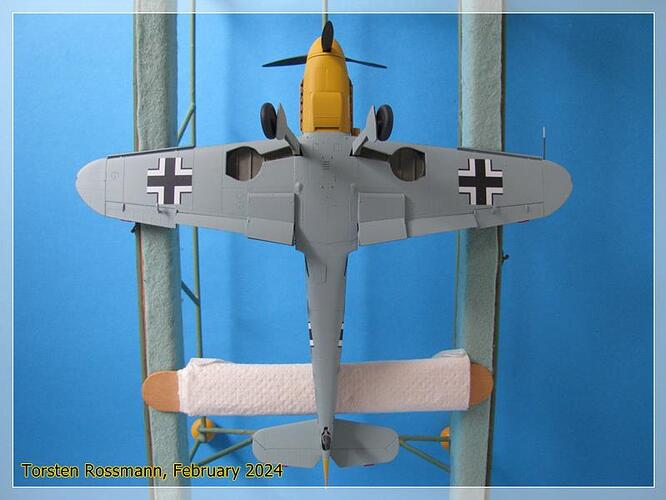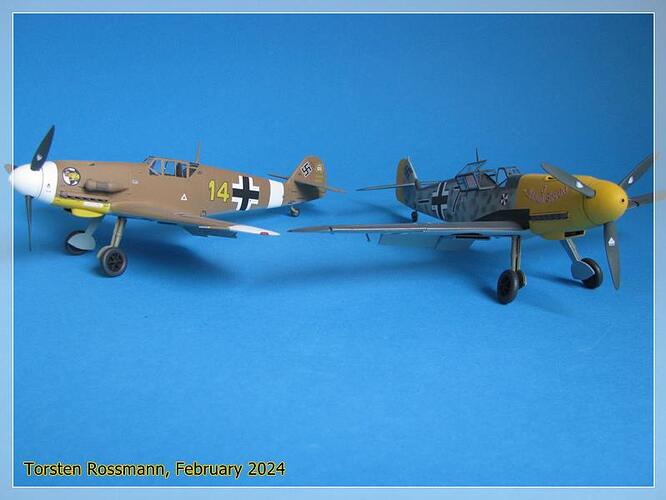And this is how I want to present my FAA Hellcats on future model show, which we hopefully will have again at the end of this year … 
Torsten,
Just an excellent photo pictorial of both your builds. Really glad i stopped by to check it out even though I posted in your build blog.
joel
Recently I have finished my latest build, the Suchoi Su-2 from Zvezda in 1/48, which I would like to show here in my Assembly Line Thread now… 
… the Suchoi Su-2 or Сухой Су-2 was a light bomber of the VVS, the Soviet Air Force, in the early years of WW2. It was developed by the Pavel Suchoi Design Bureau and made its maiden flight in August 1937. The first serial aircraft was handed over to the air force in December 1939. The production time was from 1939 to 1942 with some 900 machines built (other sources speak of about 800 built). By the start of the Great Patriotic War the Su-2 was already obsolete and underarmed. From 1942 the aircraft was withdrawn from frontline service and used as a trainer and in the reconnaissance role. As a ground attack aircraft the Su-2 suffered heavy losses against german AA fire with some 220 machines destroyed. The Su-2 had a crew of 2 and was powered by a Shvetsov ASh-82 14 cylinder radial piston engine with 1400 hp which gave the aircraft a maximum speed of 480 km/h in 5800 meters. It was armed with 4 SchKAS machine guns (7,62 mm) in the wings and one in the turret behind the pilot. The bomb load was up to 600 kg or 10 RS-82 rockets and the gross weight was 4700 kg …
… I have built “White 15” of the 210. BAP (Bombardirovochniy Aviapolk = Bomber Air Regiment) in late 1941 …
… Zvezda came out with this kit in 2013 and I had it for some time in my stash. Most parts go well together though there are some fitting issues especially on the underside where fuselage and wings meet. A bit of putty is needed here. Also the fitting of the clear parts of the gun turret is a bit tricky. But most of the time it was an enjoyable build …
… on a small decal sheet Zevzda offers 2 options for this kit. The other one is of an unknown unit in complete white winter camouflage. For painting I have mainly used Vallejo paints. The underside is painted with 71317 Russian Light Blue, the upperside is painted with 71303 Russian Cam. Green A-24 and 71057 Black. Black is airbrushed freehand. There’s a little overspray visible here and there but that’s okay for me. All interior (cockpit, bomb bay, wheel wells) are painted with Revell 76 Light Grey. Final coating is again made with Marabu Clear Matt Varnish. As usual the Su-2 is not weathered. I hope, I can show this rare bird in October this year to the public, which would be my first model show since October 2019 …
Thank you for stepping in and walking around my latest model. I hope you’ve enjoyed it.
Happy modelling!
Torsten

Great work Torsten, really like the camouflage and the soft edges
tim 
Congratulations on a beautiful addition to your assembly line, Torsten 

The Suchoi Su-2 is certainly an interesting aircraft. Recently I’ve become more and more interested in the “Eastern front” theatre of WW2 and the vehicles used in it. so this makes for a great topic to see presented! 
Thanks guys! It’s great to hear that you like my effort!
Tim, there’s no secret behind spraying the black camoflage. I have used my 0,35 mm needle, pressure about 0,2 bar (about 3 psi) and thinned the paint by 30 % with Sidolin window cleaner. And of course my steady hand … 
Russell, the Soviets had indeed some interesting aircrafts in use between 1941 and 1945. Over the years I have built a few of them, like a MiG 3 (Trumpeter), Pe-2 (Zvezda), Il-2 (Italeri/Accurate) and of course some western lend/lease used by the VVS, like the P-39 Airacobra (Eduard), Hurricane (Hasegawa) and A-20 Havoc (AMT). But they had so much more, like P-40 Tomahawks/Kittyhawks, B-25 Mitchell etc. You can even build a P-47 with Red Stars. Famous german fighter ace Günther Rall once said he was shocked when he met the first Spitfire over the russian steppe. So, yes, the Red Air Force will sure grow in the future in my collection. Still have some MiG’s, LaGG’s and Yak’s in my stash …
That’s the real advantage Torsten ![]()
tim ![]()
It’s been a while since there was some action in this thread but today I would like to show you my latest finished models from earlier in November. It’s the Eduard Spitfire Mk. II from their “Tally Ho” Dual Combo … 
… the Spitfire Mk. II was basically a Mk. I airframe, powered by a Merlin XII, which burned 100 Octane fuel. One major difference between the Mk. I and II was the cartridge starter, characterized by a small fairing on the right side of the nose, right behind the propeller. This starter allowed to start the engine without the need of an external electric source. There were some more improvements made but it would lead too far to list them all here. A total of 921 Spitfire Mk. II were built, the first delivered to No. 152 Sqn in July 1940. 751 of them were Spitfire Mk. IIa, armed with 8 Browning 7,7 mm (0,303 in) machine guns and 170 were Mk. IIb with 2 Hispano 20 mm cannons and 4 of the Browning machine guns. The Spitfire Mk. II remained in service until the end of 1941. It was replaced by the Mk. V. Some Mk. II were converted to Mk. V …
… I have built P7666 (EB-Z), a Mk. II from No. 41 Sqn, flown by SqnLdr Donald O. Finlay at RAF Hornchurch in November 1940. Finlay was a well known athletic, winning the bronze medal over 110 m hurdles at the Summer Olympics 1932 in Los Angeles and the silver medal in Berlin 1936. He joined the RAF in 1935 and led No.54 Sqn into the Battle of Britain. On the 28. August 1940 he was shot down and wounded. After recovery he took over command of No. 41 Sqn and achieved 4 kills during the BoB. He surived the war but died already 1970, just a few weeks before his 61. birthday.
The other Spitfire is P8342 (UZ-N), a Mk. IIb from No. 306 (Polish) Sqn, flown by Sgt. Marcin Machowiak at RAF Northolt in August 1941. Machowiak damaged this aircraft heavily in a crash landing after combat with a Bf 109. He achieved 1 kill over a Bf 109 and later joined the Polish Fighting Team, also known as the Skalski Circus, which was part of No. 145 Sqn in North Africa. I have no further informations about him, sorry …
… some of you have followed the build in my bench works thread so you know that this kit is a fun to build without major problems, not even at the wings/fuselage area. Only a bit of pressing was needed here. Eduard offers the option to build the Spitfire with closed canopy, with open canopy and closed door or with open canopy and open door. As there are 2 builds I decided to build one with closed and one with open canopy. For each build there is a fret of PE parts, I have used the PE parts only in the open cockpit. In the closed cockpit I have used the offered decals and Tamiya tape for the seatbelts. The Spitfire kits of Eduard are surely “state of the art” at the moment and in my opinion leave the Tamiya Spit behind …
… Eduard offers 10 decals option for this Dual Combo, 8 for a Mk. IIa and 2 for a Mk. IIb. The decals are the new ones made by Eduard and no longer by Cartograph. I have mixed feelings about them because they have a large cover film, which can be cut but can also be removed from the decal after a few hours. If you have followed my builds you know what I mean. I can recommend to remove the film only from large decals like the roundels. But they lay down nicely on the surface, though I find them a bit too sticky. For painting the camo on Mk. IIa I have used Revell 82 Dark Earth, Revell 59 Sky, Revell 302 Black and Vallejo 71016 US Dark Green. Painting Mk. IIb was done with Vallejo 71016 US Dark Green, Vallejo 71273 Ocean Grey, Vallejo 71307 Medium Sea Grey and Revll 59 Sky. Final coating was done with Marabu Clear Flat. Both builds are not weathered as usual …
… so I say thank you again for stepping in and walking around my latest builds. Hope you’ve enjoyed it.
Happy modelling!
Torsten 
The box art of this Dual Combo looks so nice that I have decided to keep the whole carton for presentation of the builds on future models shows … 
Really productive and fruitful month building the Spitfires Torsten. Really like the base they are displayed on. Thanks for taking the time with the build logs, much appreciated 
This thread has been a bit sleepy over the last few months, so I think it’s time to wake it up again with another pair of my lastest builds. Today I want to show you the Mustang Mk. IV from Eduard in 1/48 which I finished in late July. Some of you have followed the build in my Bench Works Thread so you know that from the ProfiPack I made a DualCombo … ![]()
… the RAF had to wait for their first Mustang Mk. IV until late 1944 as the USAAF Fighter Groups had priority of deliveries. The first 2 Mustangs Mk. IV were sent to the RAF in July 1944 for evaluation, followed by a first batch of 230 aircraft between September 1944 and January 1945 which were taken from Block 1 and Block 5 off the production line. Later the RAF ordered another 900 Mustangs Mk. IV of which 643 were delivered before the order was terminated in August 1945. All these aircraft were built by the Dallas factory and either painted in US camoflage or left in NMF. Some aircraft were later repainted in British camoflage scheme (text taken in parts from the Eduard instruction) …
… first I have built KH680/Y2-B “Edmonton Special” from No. 442 Sqn RCAF, based in Hunsdon/England in April 1945 and flown by P/O John Mallandine …
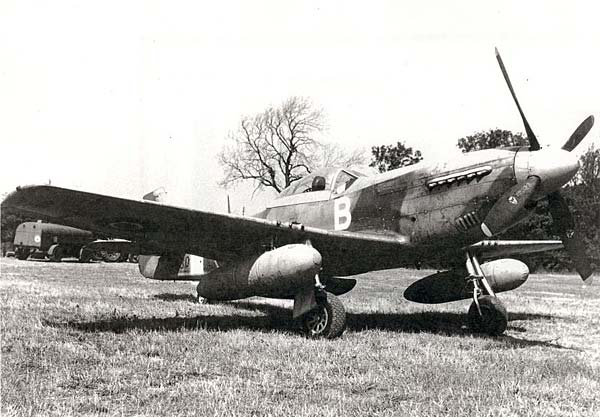
… the second Mustang Mk. IV is KH716/CV-P from No. 3 Sqn RAAF, based in Fano/Italy in January 1945 and flown by SqnLdr Murray Nash …
A big thanks to Peter and Damian for supporting my build with some photos of the original KH716 ![]()

… Eduard came out with this ProfiPack in 2021 and I ordered it immediately from their Online Shop. After I saw what nice options they offer for this kit (6 options in total) I ordered an Overtree with it plus some extra national insignias and mask EX740. In the end I guess another ProfiPack would have cost me the same money. The build goes well together, there are no major fitting issues. I noticed the wheel bays are a bit too high to fit inside the wings so I had to sand some material away. To get the wings together with the fuselage is also a bit tricky, so I needed a few dry fitting tests before I added glue to the party. It needs a bit pressure with clamps or rubber bands for some time. But that’s about it with problems during the build. The PE parts I have used only on KH680, on KH716 I have used decals when they are provided …
… the paint work on KH680 was basicly made with Vallejo paints. Medium Sea Grey 71307 for the underside and Ocean Grey 71273 and RAF Dark Green 71324 for the upper side. The anti glare panel is painted with Lufthansa Gelb 310 from Revell Aqua. The fuselage band is Sky 59 also from Revell. The interior on both Mustangs was painted with Interior Green 71010 from Vallejo. Main painting on KH716 was made with Silver 90 from Revell Aqua, the anti glare panel with Black 302 also from Revell. The blue rudder is painted with Sky Blue H25 from Gunze. While the RAAF Mustang is not sealed to keep the metallic shine, KH680 got a final coating with a 60/40 mix of Revell Clear Gloss and Clear Matt. All decals are taken from the Profi Pack and the extra national insignias for KH716. On the RCAF Mustang I took off the transfer film from the bigger decals, which is a new technique from Eduard since 2019. But like on the Spitfires above I noticed that this is not really necessary if you cut the transfer film close to the decal.
This kit is really a nice build which I can highly recommend, though I still have some Tamiya and Hasegawa Mustangs in my stash. The Mustangs were fun to build. Thanks to everyone who supported me during the build and for taking this walk around the new members of my every growing Plastic Air Force.
Happy modelling!
Torsten
![]()
Lovely additions to your plastic airforce, Torsten. ![]()
Would be nice of Eduard if they downscaled these kits to 1/72😁
Thanks Russell! ![]()
I doubt that Eduard will bring out a Mustang in 1/72, as they usually don’t do with other kits. Best example is their MiG 15, which you get in 1/72 but not in 1/48. Same with the Avia S-199. I don’t believe I’ll get one in 1/48. But maybe Vladimir Sulc proves me wrong one day …
Today I want to show you my last finished model in 2022. It’s the Junkers Ju 87 D from Hasegawa in 1/48, which I have finished early in December … ![]()
… the Ju 87 “Stuka” is one of the most iconic aircraft of WW2, so I don’t think there’s any introduction necessary. Of less than 6000 built aircraft, nearly 3500 were the “D” sub type. Beside Germany, the main users were Italy, Hungary and Romania. The Ju 87 D was build until late 1944 and was powered by a Jumo 211 engine with 1420 hp, which gave the aircraft a maximum speed of 400 km/h. The typical payload was one 500 kg bomb under the fuselage and two 50 kg bombs under each wing …
… I have built aircraft “861”, a Ju 87 D-5 of the Esc. 86, Grupul 6 of the ARR (Aeronautia Regala Romana), the Royal Romanian Air Force, flown in the southern sector of the Eastern Front in Summer 1943. Romania used about 90 Stukas …
… some of you have followed my build blog, so you know that this kit is quite an oldie. The original mould came out in the late 1990’s and this limited edition in 2006. The kit gave me not much trouble, only at the transition between fuselage and wings I had a gap to fill with putty. I also built some kind of landing light in the left wing with Evergreen Profiles as there was nothing but a hole. The rest was really fun to build …
… painting was done with Revell Aquas paints, the main paints are RLM 70 Black Green, RLM 71 Dark Green, RLM 65 Light Blue and RLM 04 Yellow. The splinter camo turned out to be a masking monster as usual. I guess half of the time was spend with happy masking. The decals are all from the kit, though I don’t think all stencils were left on this heavily used aircraft. Despite its age of nearly 20 years they were not brittle and went on the surface without any problems. Final coating was again made with a 70/30 mix of Revell Clear Gloss and Clear Matt. As usual the Stuka is also not weathered.
Thanks for walking around my new model!
Happy modelling also in 2023!
Torsten ![]()
Man, you never fail to bring a smile… WOW!
Another fantastic build, Torsten ![]()
![]()
![]()
A really great rendition of the Stuka! ![]()
![]()
Thanks guys! ![]() Glad to hear that you like what you see here. Still have the Nakajima …
Glad to hear that you like what you see here. Still have the Nakajima …
Oh man! Last post here was more than a year ago! ![]() Have been quite lazy here but not unproductive in building at all. Time to breath some life into this thread again!
Have been quite lazy here but not unproductive in building at all. Time to breath some life into this thread again!
So, today I would like to show you my latest finished models. The Messerschmitt Bf 109 F-2 and F-4 from Eduard, as always in 1/48 scale. The F-2 is a ProfiPack, while the F-4 is a Weekend Edition … ![]()
… the Bf 109 F series was a major improvement to the Bf 109 E. There were numerous aerodynamical changes, giving the One-O-Nine the shape which was close to the definitive appearance. The engine cowling was completely redesigned and was more rounded and streamlined. The spinner was larger and its shape transitioned smoothly into the line of the front fuselage. The oil cooler radiator below the nose was also streamlined. The wing lost its typical rectangle shape as new rounded wingtips were developed. The armament was also revised and consisted of two 7,92 mm MG 17 machine guns mounted on top of the engine and one 15 mm MG 151 cannon (20 mm MG 151/20 in the F-4) firing through the propeller spindle. The new aircraft was well received as it was the best handling Bf 109 of them all according to many pilots. The F-2 was using a VDM 9-11207 propeller driven by the DB 601N engine. The F-4 was using the VDM 9-12010 with broader blades and got the new Mauser MG 151/20 20 mm cannon. The first F-2 arrived at the units in Oktober 1940 and production ran until August 1941. A total of 1230 Bf 109 F-2 were produced during this time. The first F-4 arrived in June 1941 at the units and production ran until May 1942. A total of 1841 Bf 109 F-4 were produced … (text taken from Eduard)

… my F-4/Trop was from 3./JG 27, the last “Friedrich” flown by famous Hauptmann Hans-Joachim “Jochen” Marseille in Egypt in September 1942. After his return from a visit in Rome Marseille flew this aircraft (Wk-Nr. 8673) between 24. August and 25. September 1942 and achieved 49 victories with it. The rudder on this model shows 151 bars. His last 7 victories he achievd on the 25. September 1942. Marseille flew a total of 382 missions. With another pilot at the controls it was shot down by AA fire at El Alamein on the 22. October 1942. So it survived Marseille by 3 weeks …
… my F-2 was from 5./JG 3 in Germany in April 1941, flown by Leutnant Horst Buddenhagen, who flew already “Emils” with 5./JG 3 during the Battle of Britain (named Schluck-Specht and 2. Schluck-Specht ). He achieved 4 victories between 3. June and 27. September 1940. Back in Germany the unit transfered to F-2 and so this aircraft got the new name. Early in June 1941 the squadron flew to Poland for the beginning of Operation Barbarossa. It’s most likely, that “Black 7” had this beautiful yellow nose only up to that date. Buddenhagen flew up to 6 missions per day and achieved another 4 victories between the 23. and 25. June 1941. In the evening of that day the squadron flew one last low level mission with bombs and attacked russian targets. Buddenhagen flew very low and was probably hit by AA fire. “Black7” touched the ground, crashed and exploded. Buddenhagen was instantly killed.
… if you have followed my build blog you know that these kits are a pleasure to build. No big problems on both aircraft, I have used only some putty on the transition between fuselage and wings. On the F-2 a bit more but that was no big deal. I decided to built “Black 7” with an open canopy because I used some of the PE parts here. “Yellow 14” got the closed canopy because of the decals used in the cockpit. The only PE parts here are the grilles for the sandfilter, which were not needed on the other build. For painting I have used Vallejo Model Air. Camouflage on Marseille’s “Yellow 14” was mainly done with No. 71101 Light Blue RLM 78, 71278 Sand Yellow RLM 79, 71078 Yellow RLM 04 and 71279 Insignia White. Buddenhagen’s “Black 7” was a little more difficult to paint, the camo was done with 71257 Light Blue RLM 76, 71258 Dark Grey RLM 74, 71259 Grey Violet RLM 75 and 71078 Yellow for the beautiful yellow nose. Mottling was done with Gunze H68 (RLM 74) and H69 (RLM 75) …
… decals are taken from the kits and they go on the surfaces without problems. 30 seconds in warm water and that’s it. Though the decals of “Yellow 14” were a bit stickier than of “Black 7”. But nothing to worry about. Finally both Friedrich together …
I want to thank again everybody who has joined me in my build blog and I hope you’ve enjoyed the little walk around here. I promise to be more active in this thread in the future … ![]()
Happy modelling and take care!
Torsten
![]()
This duo is a fantastic addition to the “circus” Torsten. ![]()
It really was interesting learning the history of the each aircraft, their pilots and their eventual fates as well ![]()
Thanks for your feedback, Russ! Much apprechiated ![]()
It’s always interesting for me to learn something about the pilots who flew the machines, no matter what uniform they wore. Sometimes the search takes longer than the building and often I’m happy to find just a little bit. No problem to get informations about Marseille in the internet, but Buddenhagen was “one of the many others”. Not much help from the internet here, but the german magazine “Luftwaffe im Focus” from where I got the photo of the original “Black 7” has it all.
